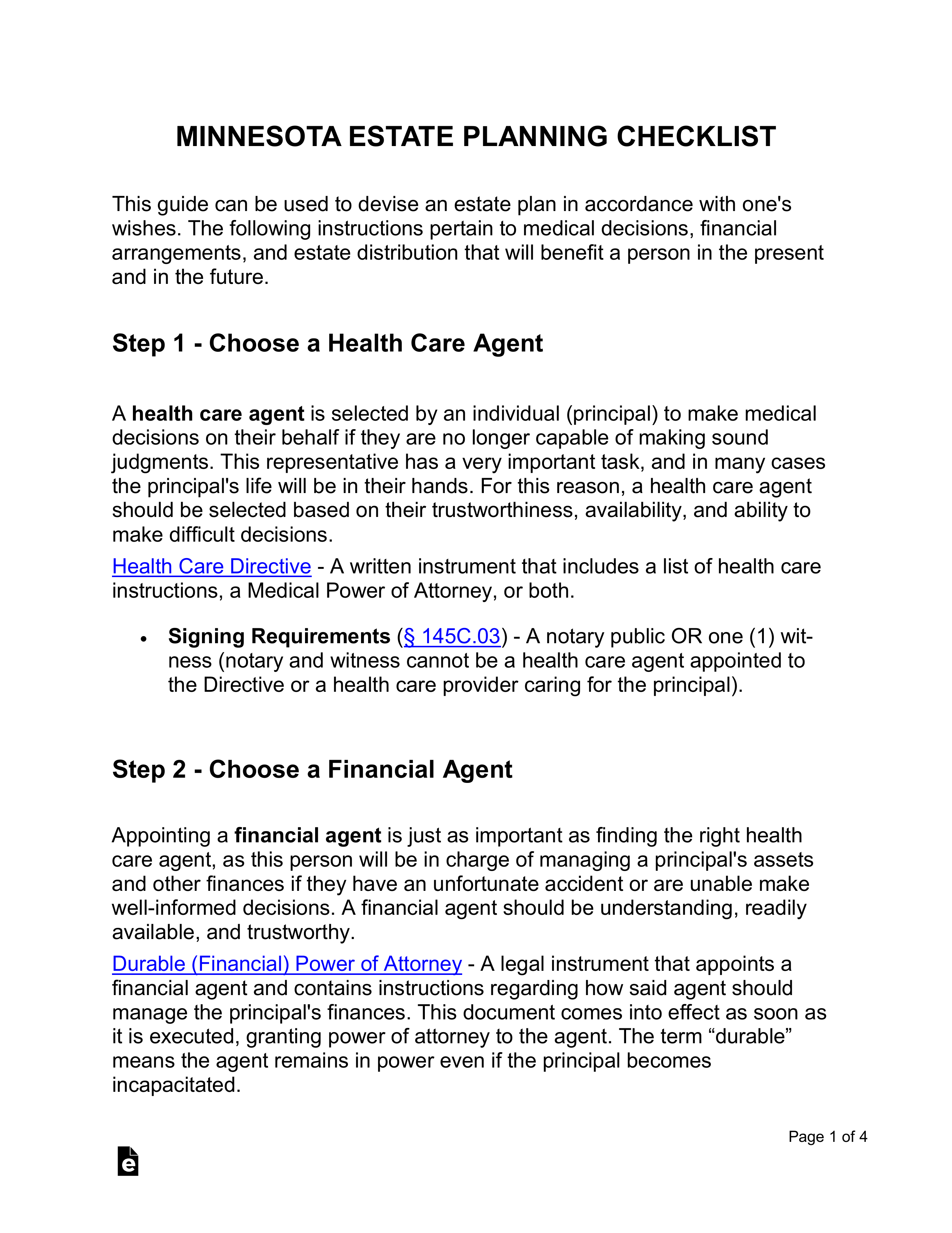Updated March 05, 2024
A Minnesota estate planning checklist outlines a list of documents that explain a person’s wishes and needs pertaining to important medical and financial decisions in the event of incapacitation. It helps people stay organized while planning their future medical and financial needs. Another part of this planning process includes decisions regarding the distribution of assets and property to named beneficiaries after a person dies. Representatives/agents must be appointed in each estate planning instrument; a health care proxy for a Health Care Directive, a financial agent for a Durable Power of Attorney, an executor for a Last Will and Testament, and a trustee/successor trustee for a Revocable Living Trust. Someone planning their future will be able to better keep track of their affairs with the assistance of the Minnesota estate planning checklist.
How to Create an Estate Plan in Minnesota (6 steps)
- Choose a Health Care Agent
- Choose a Financial Agent
- Make a List of All Assets and Real Estate
- Designate Beneficiaries
- Create Last Will and Testament or Living Trust
- Safely Store the Documents
This guide can be used to devise an estate plan in accordance with one’s wishes. The following instruments pertain to medical decisions, financial arrangements, and estate distribution that will benefit a person in the present and in the future.
1. Choose a Health Care Agent
A health care agent is selected by an individual (principal) to make medical decisions on their behalf if they are no longer capable of making sound judgments. This representative has a very important task, and in many cases the principal’s life will be in their hands. For this reason, a health care agent should be selected based on their trustworthiness, availability, and ability to make difficult decisions.
Health Care Directive – A written instrument that includes a list of health care instructions, a Medical Power of Attorney, or both.
- Signing Requirements – A notary public OR one (1) witness (notary and witness cannot be a health care agent appointed to the Directive or a health care provider caring for the principal).[1]
2. Choose a Financial Agent
Appointing a financial agent is just as important as finding the right health care agent, as this person will be in charge of managing a principal’s assets and finances if they have an unfortunate accident or are unable make well-informed decisions. A financial agent should be understanding, readily available, and trustworthy.
Durable (Financial) Power of Attorney – A legal instrument that appoints a financial agent and contains instructions regarding how said agent should manage the principal’s finances. This document comes into effect as soon as it is executed, granting power of attorney to the agent. The term “durable” means the agent remains in power even if the principal becomes incapacitated.
- Signing Requirements – Principal, notary public, and the attorney-in-fact.[2]
Financial Powers Allowed (at the Principal’s behest):
- Real property transactions;
- Tangible personal property transactions;
- Bond, share, and commodity transactions;
- Banking transactions;
- Business operating transactions;
- Insurance transactions;
- Beneficiary transactions;
- Gift transactions;
- Fiduciary transactions;
- Claims and litigation;
- Family maintenance;
- Benefits from military service;
- Records, reports, and statements; and
- All of the powers listed above and all other matters, other than health care decisions under a health care directive that complies with State statutes.
3. Make a List of All Assets and Real Estate
4. Designate Beneficiaries
5. Create Last Will and Testament or Living Trust
Whether to draft a Last Will and Testament or a Revocable Living Trust depends entirely on the principal’s financial situation and intentions regarding the distribution of their assets. Regardless, it’s important that a document is created before the principal’s death to allow for a smooth transfer of property thereafter.
Last Will and Testament – A Will is a document containing instructions regarding the distribution of the testator’s (principal) assets after they die. An executor is appointed as the representative of the Will to see that each named beneficiary receives what was passed on to them by the testator.
- Signing Requirements – The testator and two (2) witnesses.[3]
Revocable Living Trust – The execution of this document establishes the Living Trust as an entity, to which the grantor (principal) transfers ownership of their assets. A trustee will be appointed to handle the Trust’s affairs (typically the grantor) and successor trustees will be selected to handle the assets after the grantor’s death. The grantor continues to benefit from the assets during their lifetime and names beneficiaries to inherit the estate after they die.
- Signing Requirements – Not statutorily mentioned; however, the grantor, trustee and successor trustees must sign, and it is recommended that they do so in the presence of a notary public.
Main Difference – A Revocable Living Trust is easy to amend and has the added benefit of avoiding probate court. A Last Will and Testament (unless containing a Self-Proving Affidavit) could take months or even years to process in probate, depending on the size of the principal’s estate and the amount of debt they owe.
6. Safely Store the Documents
Alabama Estate Planning Laws
- Health Care Directive – § 145C
- Durable Power of Attorney – § 523
- Last Will and Testament – § 524.2-(501-517)
- Living Trust (Revocable) – § 529


